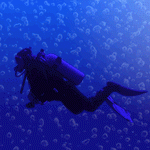DreamDiver, excellent! Thank you for sharing that info. I was going to look up how an oximeter works after I come back from my walk.DreamDiver wrote:Here's why:Undoubtedly there is more going on than this firmware-wise, since the light winks if there is no finger in the clip and emits continuously if there is a finger present. I'm guessing an infrared powerful enough to blister tissue at 650nm uses more mA than a red led at 805nm. What do you think?How does an oximeter work?
A source of light originates from the probe at two wavelengths (650nm and 805nm). The light is partly absorbed by haemoglobin, by amounts which differ depending on whether it is saturated or desaturated with oxygen. By calculating the absorption at the two wavelengths the processor can compute the proportion of haemoglobin which is oxygenated. The oximeter is dependant on a pulsatile flow and produces a graph of the quality of flow. Where flow is sluggish (eg hypovolaemia or vasoconstriction) the pulse oximeter may be unable to function. The computer within the oximeter is capable of distinguishing pulsatile flow from other more static signals (such as tissue or venous signals) to display only the arterial flow.
Mine doesn't show through the side. It's very dim light. Dimmer than my alarm clock - and that's really dim. It's just a slightly glowing red finger from the side.
I also know now that even when it appears to be constant, as I had also thought before, it is really pusling. You can check that by moving your finger around. I have not looked up the efficiencies of those leds, they could be using about same amounts of current, but they get the power by pulsing for a very short duration at high current, the duty cycle might be as low as 1/10 or even 1/100. It winks when there is no finger to save even more energy; makes sense. BTW, I had used IR led at another project and have learned that it is better not to look straight into it, because our eye does not respond by reducing the iris opening. Also you can see the light if you take your digital camera and look at it, it might appear brighter than the red one.
The light coming through the side might depend on the geometry of our finger. What I see at night is not diffused, I can see the led directly through the side and at night it is very bright. But it is easy to apply masking tape, I put a little hanging blinds type flap of tape on one side partly folded over on itself, so I do not have to remove it every morning.















